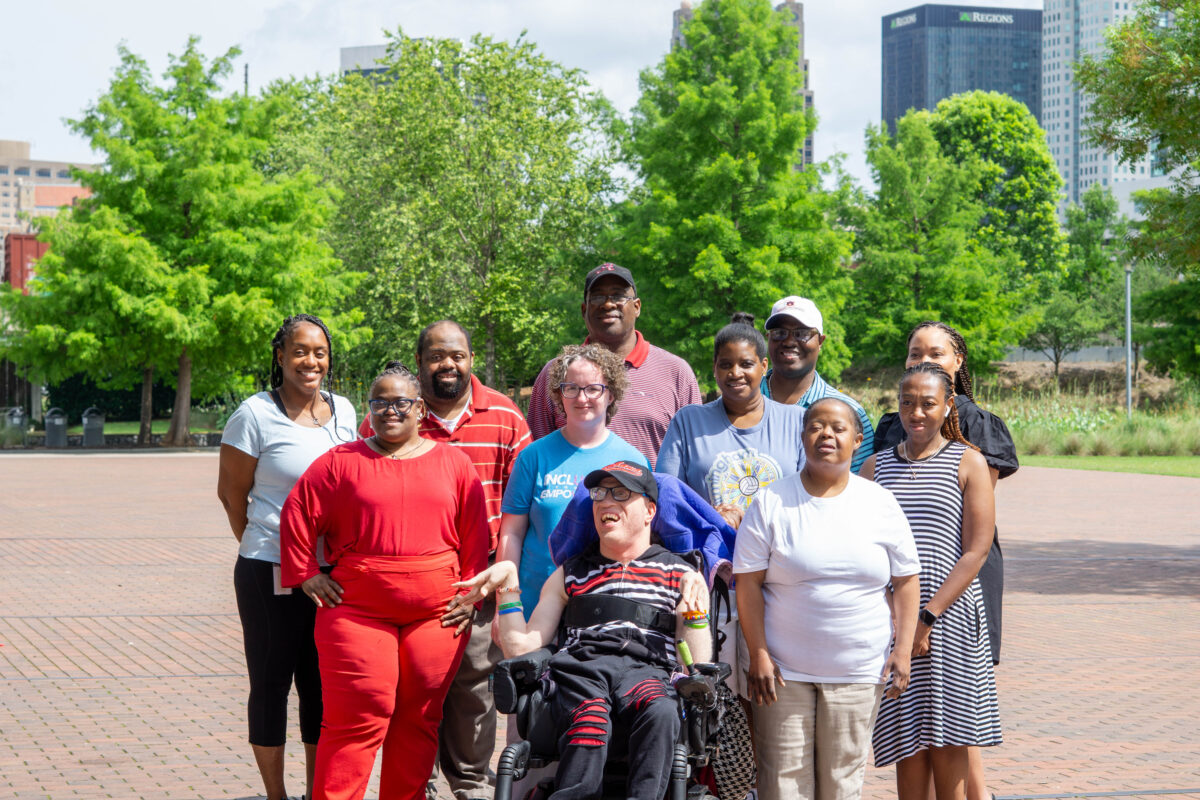The local feral cat issue is in crisis. Meet one resident tackling the problem
Reading time: 10 minutes

Walking around my neighborhood, you’ll quickly notice that feral cats almost outnumber the human residents. And while they may be cute, they’re definitely a problem. Birmingham resident Kathy Stiles Freeland is leading an initiative against the issues feral cats wreak on our environment—here’s how.
Important vocab you should know before diving in 🐱
- Ferals = a feral, un-owned domestic cat that lives outdoors and avoids human contact
- The clinic = Alabama Spay/Neuter Clinic, a nonprofit offering low-cost spay/neuter services in Irondale, AL
- Feeders = feral cat caretakers who provide food to cats, but do not own them
- Fixed = spay/neutered
- TNR = trap, neuter, release
Meet Kathy Stiles Freeland and learn about her important work

Kathy Stiles Freeland works part-time as a Feral Cat Project Coordinator at the Alabama Spay/Neuter Clinic in Irondale. Her position involves overseeing the TNR program—Trapping feral cats, sending them to get spayed or Neutered and Returning them to the streets.
Kathy has been trapping feral cats since 2008
But it she started when she was a little girl. Since she was a child, Kathy’s always rescued cats, However, back then, spaying/neutering your pets wasn’t really an option.
When she became a young adult, Kathy learned about the importance of spaying and neutering. And, despite the expense, she started having a veterinarian do the surgery on her own cats.
Later, Kathy bought a cat trap and began setting it in her yard when she noticed how many strays and ferals wandered about it due to her bird feeders. After capturing the cats, she’d take them to be fixed. As you can imagine, this is not an inexpensive task.
“A major turning point for me was in 2008. I got a flyer in the mail announcing the opening of the nonprofit Alabama Spay/Neuter Clinic in Irondale. I could not believe it! One, because there was actually a low-cost spay/neuter clinic in Birmingham, and, two, that it was conveniently located near where I lived. I thought the Cat Goddess had sent me a gift.”
Kathy Stiles Freeland, Feral Cat Project Coordinator, Alabama Spay/Neuter Clinic
In 2009, Kathy’s activity in the community increased

It wasn’t long before Kathy became a regular client at the Alabama Spay/Neuter Clinic in Irondale. In 2009, she retired after her second stint as Ruffner Mountain Nature Center’s Executive Director.
With more time on her hands, Kathy expanded her reach and began trapping cats in the South East Lake Community. Today, Kathy has three trap locations in the area.
How Kathy came into this unique position

Kathy has served as the Feral Cat Project Coordinator at Alabama Spay/Neuter Clinic for six years. While it’s obvious she’s always been the best person for the position, the job was offered to her after tackling a massive undertaking in Chilton County.
The clinic’s director, Mark Nelson, saw Kathy as a regular client and enlisted her expertise after a call came through from a desperate elderly couple.
“Mark had gotten a request to partner with Alley Cat Allies to help an elderly couple in Chilton County who begged for help for their 30 plus cats. Some were their own and others had just dropped at their house in the countryside.
Mark asked me if I would be willing to do a trapping there, using traps they had. I was also told three other volunteers would join me to help.”
No task too catastrophic
The clinic delivered the traps to the couple’s home and Kathy drove to the site with her preferred cat bait, mackerel. However, en route, she received calls from the three volunteers with news they would not be able to make it.
“I panicked. But, I am a goal-oriented person. I said I would trap those cats and I decided to go ahead and try. It took a full day and a half but I was finally able to call Mark to have the driver come and pick up the 39 cats in the traps.
I smelled like a can of mackerel, too. Mark soon asked me if I would be interested in a very part-time job at the clinic as Feral Cat Project Coordinator.”
Trapping feral cats 101

My biggest question for Kathy—how does it work? As much as I love cats, ferals are nothing to be trifled with and I was struggling to understand exactly what a day in the feral cat trapping business looks like. Here’s a step-by-step list of a typical day for Kathy.
1. It starts with a phone call.
Kathy returns phone calls the clinic receives from feeders, assesses the situation and then determines what financial and other resources are needed.
2. The subject and location are identified.
“The process I use is to identify the time and location that the cats are fed by their caretaker. The caretaker is asked not to feed the cats the day before so that they are hungry enough to venture into that odd-looking ‘cage’ I set out.
I set the traps out an hour or so before the cats expect the food to be put out for them and then get in my car or the caretaker’s home if possible and watch.
As the cats are caught, I quickly put a cloth cover over the trapped cat to reduce the stress they are feeling. I also remove the trapped cat to a shady location or in my vehicle to keep from scaring the other cats away.”
3. The cats are transported to the clinic.
Kathy never leaves the cats once they’re trapped. She takes them to the clinic on Sunday and provides the ferals with food and water. Then, Kathy completes paperwork so the staff is ready to go on Monday.
4. The spaying/neuter takes place.
The cats are typically fixed within a day or two of arriving at the clinic. All feral cats have their left ear tip cut. This is because it serves as a universal sign the cat has been spayed/neutered.
5. Cats are returned.
Once all is said and done, Kathy takes the cats back to the location where they were trapped—usually a residential, business or rural area. She never relocates the cat to a totally new place.
If kittens wind up in the mix, Kathy attempts to get them fostered and socialized so they can have a chance at adoption.
Wait, why is this so important?

So what, feral cats pretty much stay out of everyone’s way, right? Well, not when it comes to the toll they take on native birds and other wildlife.
Kathy says there’s a lot of controversy among environmental organizations about just how to handle the problem. While some advocate for trapping and killing the cats, Kathy has found her methods to be more ideal.
“Studies have shown that TNR is the best solution to reduce the number of cats. I agree. I have witnessed in my neighborhood how fewer stray cats there are after over 11 years of my work trapping and fixing cats.
I once told the President of the National Audubon Society that he didn’t want to pick a fight with ‘crazy’ cat people, because those were most likely the organization’s membership base. If you like cats, then you most likely also care about wildlife.”
A long back ground as an environmental advocate
Kathy is a long-time conservationist and has been involved in numerous Alabama environmental organizations since the ’70s, as both a volunteer and an employee.
“Alabama’s natural heritage is amazing and I am proud of my part in preserving a lot of it.”
Take a look at her work over the years:
- 1979-1989: Founding Executive Director of Ruffner Mountain Nature Center
- 1989-2002: Founding Executive Director of the Alabama Chapter of The Nature Conservancy
- 2004-2009: Returned as Executive Director of Ruffner Mountain Nature Center to oversee the fundraising for and construction of a new state of the art nature center building
Helping cats and the environment
“Some of my environmental friends, especially the biologists, have been perplexed by this new (to them) focus of mine on feral cats. But I see it as an extension of my conservation work.
I am able to reduce the number of cats that prey on birds and other wildlife and I am able to improve the lives of the cats since they are no longer reproducing litter after litter of kittens. Or, in the case of male cats, suffering sometimes deadly injuries from fighting over females. Those fierce male cats often become the most loving and sweet cats of all once they are neutered.”
Another vital reason for fixing feral cats is limiting the number of animals euthanized in shelters. Since 2008, the clinic has spayed/neutered thousands of animals. This, combined with the work of dedicated volunteers, stops overcrowding in shelters and makes a major difference.
You can join in on the feral cats adventure, too

Volunteer
“Volunteers are always needed. There are always cats to trap and fix. It isn’t hard to do, but it takes dedication, some physical strength, traps, something for bait (mackerel, canned cat food, etc.) and cloth covers for the traps. It also takes a vehicle capable of hauling several cats in traps and a source of funds.”
- Traps can be rented by the public from the clinic.
- Feral cats are accepted at the clinic only on Mondays and Tuesdays. Anyone can bring a feral cat in a trap on these two days.
- Contact: More information on how to become a volunteer | Call the clinic at 205.956.0012
Donate
- Funds: Donate money to the Kathy Stiles Freeland Feral Fund with checks made payable to Alabama Spay/Neuter Clinic, 2721 Crestwood Blvd, Irondale, AL 35210.
- Donate items: Cans of mackerel, broken down cardboard boxes that can be cut to fit traps, old sheets or blanket that can be cut for trap covers
Educate
Kathy has taught a workshop on TNR before and plans to again once the COVID-19 situation is no longer a threat. In the meantime, learn more about the process, the differences between a stray and feral cat and the importance of spaying/neutering through the following resources:
- Alabama Spay/Neuter TNR Program
- Alley Cat Allies
- A Closer Look at Community Cats and TNR from the ASPCA
What does the future of cat trapping look like for Birmingham?
“I am in my mid-70s now and have been lucky to date to still be healthy and physically able to lift a trap with a 15 pound very angry tomcat in it. But I am attempting to slow down.
My goal is to train more volunteers to do this work and really retire. I want to complete a couple of books I have been working on. One about my conservation work in Alabama, and yes, one about this other career of mine, cat trapping.”



